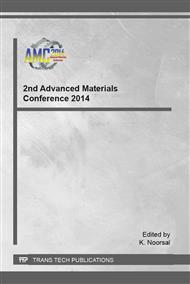p.38
p.45
p.50
p.55
p.60
p.65
p.70
p.75
p.80
Effect of Time on the Fabrication of Bioresorbable Biphasic Granules of Gypsum-Carbonated Apatite for Paediatric Orthopaedic Application
Abstract:
A carbonated apatite (CO3Ap) has a closer chemical composition to the bone mineral which may be suit as an artificial bone substitute. In this study, the fabrication works of biphasic gypsum-carbonated apatite granules has been done through the phase transformation by carbonation and phosphorization of the gypsum granules. Gypsum also known as calcium sulphate dihydrate (CSD) granules was immersed into the 2 M of carbonate and phosphate salt solution at 50 °C and room temperature in variable time. The effect of time on the fabrication of biphasic granules were studied using X-ray diffraction (XRD), Scanning Electron Microscopy (SEM) and Fourier transform infrared (FTIR). The XRD analysis was done to confirm the formation of gypsum and hydroxyapatite phases in the biphasic granules. The FTIR spectroscopy indicated that the formation of carbonate apatite was formed in these biphasic granules. The cross sectional morphology of the biphasic granules was observed using SEM. The compositional elucidation was quantitatively measured by CHN analysis to obtain the contents of CO3.Based on the results obtained, it is observed that the CSD was successfully transformed into carbonated apatite to form biphasic granules and time had influenced on the fabrication of these biphasic.
Info:
Periodical:
Pages:
60-64
Citation:
Online since:
January 2016
Price:
Сopyright:
© 2016 Trans Tech Publications Ltd. All Rights Reserved
Share:
Citation:


